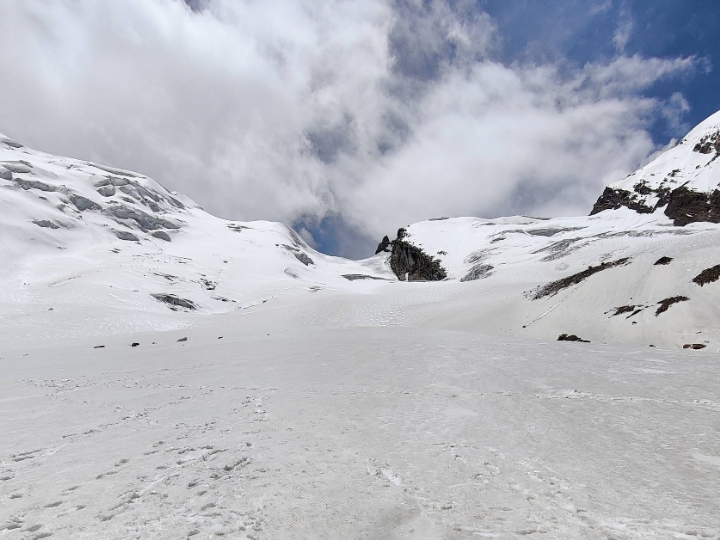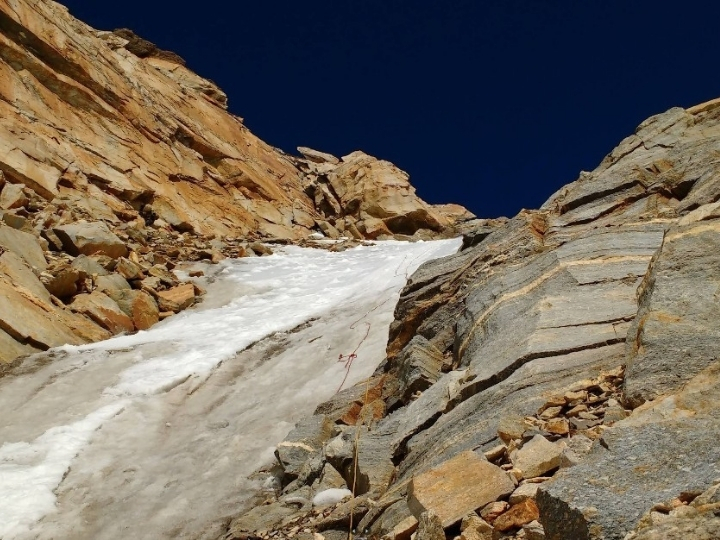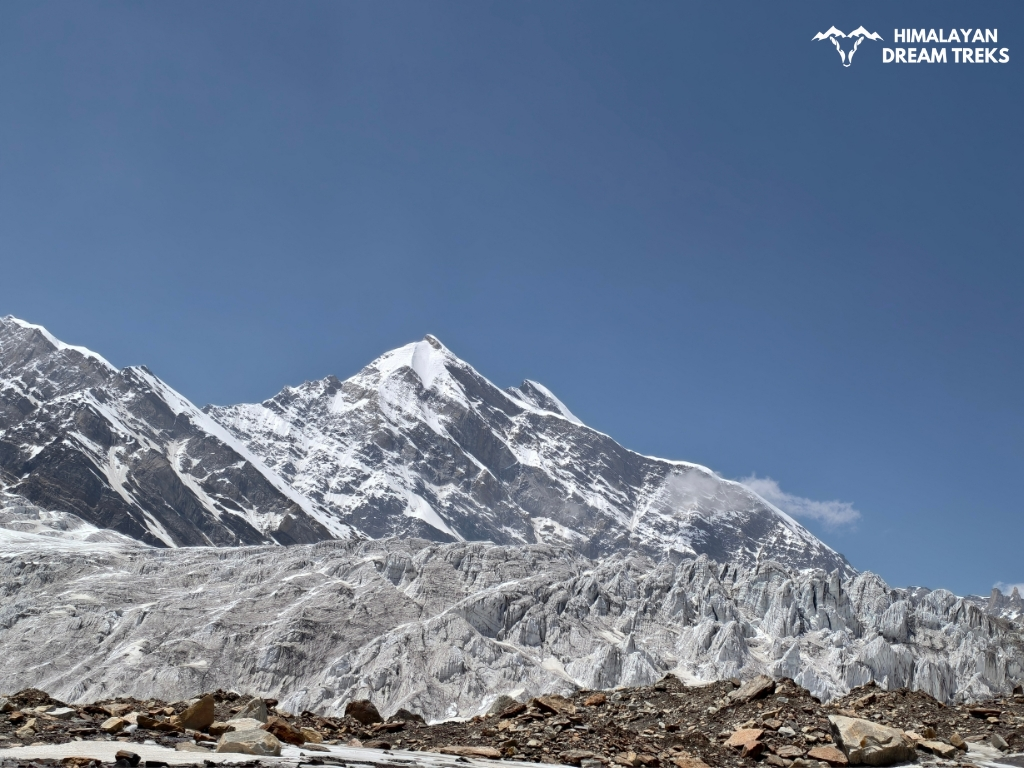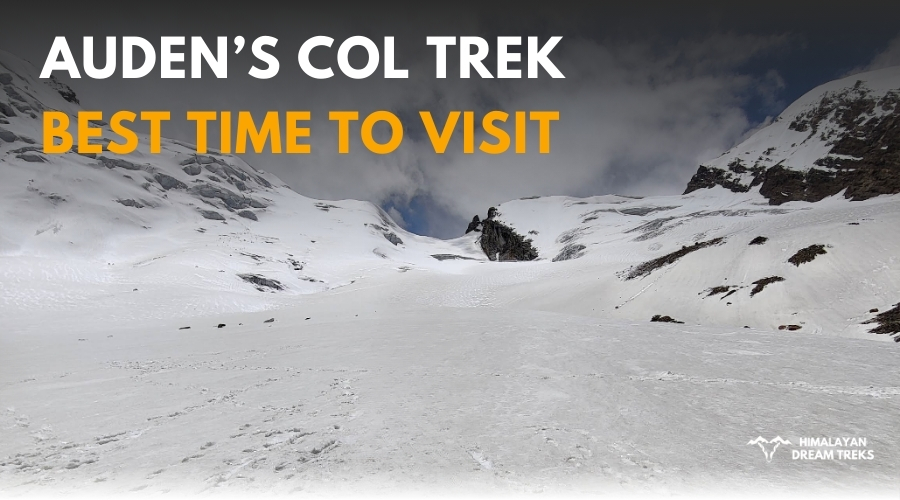Auden’s Col is one of the most dangerous passes in the Garhwal Himalaya of Uttarakhand, as it crosses the highly crevassed Khatling Glacier. The pass lies at 5,490 m (18,012 ft) and connects the ridge coming from Gangotri III on the northwest with the ridge from Jogin I on the east. Weather, snow, and glacier conditions at this elevation change quickly, and for this reason, it holds a prominent place among the most difficult treks in India. For any expedition here understanding the best time is important. Stable days, visible crevasses and firm snow reduce risk, support steady movement and keep the team focused on a slow safe approach. For this route the most suitable windows are May to June and September to October. In these periods the pass, the Khatling Glacier and the long glacier sections are more manageable and the landscape from forest trails near Gangotri to vast snowfields above stays clear enough to move with care.

Best Time For Auden’s Col Trek
On Auden’s Col, difficulty comes from altitude, crevasses, steep ascents, thin ice, and long moraine and scree sections. Picking the right season helps with all of these. The best time to do the Auden’s Col Trek is from late May to June and again from September to early October, when the weather is more favorable, the trail is accessible, snow levels are lower, and visibility is better. This wonderful time to enjoy the region ensures fewer storms, a stable atmosphere, and less snow, which allows trekkers to move more safely across the Col and the Khatling side. When the snow is less and hard and the cracks are exposed, it is easier to find safe lines on the pass and glacier. Sub-zero temperatures remain, but fewer storms and clearer skies help with navigation. A stable weather window allows planned acclimatization days, measured altitude gain, and a calm pace between Gangotri, Rudugaira, the Col, Khatling Zero Point, and beyond. With clear conditions, the team can set fixed ropes where needed, move over boulders without rush, test thin ice, and cross tricky sections with ropes and an experienced guide. In short, the right season does not make Auden’s Col easy, but it lowers exposure and keeps the expedition controlled.
Auden’s Col Trek in Possible Season
Trek in Summer (May to June)
Summer offers the most favorable conditions for Auden’s Col. There is less chance of rainfall and fresh snow. Sub-zero nights continue near the Col but days often stay clear with temperature ranging from 5–10°C. Residual snow appears at base camps near Gangotri and Rudugaira Valley while the Khatling side still holds large snowy areas. The thawed snow reveals many crevasses so the dangerous sections are more visible. Moraine and scree are present yet firm footing is more likely. With fewer storms the team can move in a slow organized way: forest trails near Gangotri, scree and loose boulders to Rudugaira Base Camp, the steep climb to the Col base and a steady push to the summit on a vast expanse of snow. The descent toward Khatling Glacier remains serious but a clear line to the zero point and careful rappels help keep the route within control. Alpine greenery in the lower sections and small Himalayan villages on exit add calm scenery without changing the core nature of this high-altitude corridor.


Trek in Autumn (September to October)
Autumn brings comfortable weather, visible crevasses and the onset of winter. October may have occasional snowfall yet storms are fewer than in monsoon. Typical temperatures range from 0–10°C during the day and drop below freezing at night. The snow on the Col and on Khatling is often firm. Knee-deep snow can appear after a snowstorm so rope work and testing with care remain vital. Brown hues in the Gangotri region and the Bhilangana Valley give clear open views of the Jogin and Gangotri ranges under calm skies. The route still includes steep ascents, near vertical sections on snow, loose moraine and big crevasses on the Khatling side. With stable days the team can hold a slow pace, manage altitude gain and keep safe positions while moving on ridges and snowfields. For seasoned trekkers who seek a winter-like feel without full winter risk this window is the right balance.

Not Recommended Windows
- Monsoon (July to August): unpredictable rain on rocky and glacial terrain, slippery moraine and scree, landslides, mudslides, avalanches and sub-zero nights make it life threatening.
- Winter (November to April): extremely harsh weather, frequent snowfall, trails blocked, soft snow masking crevasses and the Gangotri National Park side closed. Auden’s Col is not possible in winter.
Short Itinerary of the Route-
- Day 1: Drive from Dehradun to Gangotri
- Day 2: Acclimatization Day at Gangotri
- Day 3: Trek from Gangotri to Nala Camp
- Day 4: Trek from Nala Camp to Rudugaira Base Camp
- Day 5: Acclimatization at Rudugaira Base Camp
- Day 6: Trek from Rudugaira Base Camp to Auden’s Col Base via Gangotri Base Camp
- Day 7: Trek from Auden’s Col Base to Khatling Glacier via Auden’s Col
- Day 8: Trek from Khatling Glacier Campsite to Zero Point
- Day 9: Rest Day at Zero Point
- Day 10: Trek from Zero Point to Chowki
- Day 11: Trek from Chowki to Masar Tal
- Day 12: Trek from Masar Tal to Vasuki Tal via Mayali Pass
- Day 13: Trek from Vasuki Tal to Kedarnath
- Day 14: Trek from Kedarnath to Gaurikund
- Day 15: Drive from Gaurikund to Dehradun/Rishikesh
- Day 16: Extra Day or Buffer Day
Read more about the detailed itinerary of Auden’s Col Trek.
History of Auden’s Col and its First Expedition
The pass is named after John Bicknell Auden of the Geological Survey of India. He discovered the Col in 1935 and crossed it in 1939 from the Gangotri side up the Rudugaira Valley, over the Col and the Khatling Glacier, and down to the Bhilangana Valley. This crossing stands as a notable achievement in Himalayan mountaineering. The route remained unexplored for 44 years after that attempt. In 1983 Harish Kapadia and Romesh Bhattacharjee from the Himalayan Club repeated Auden’s explorations and achieved a second successful crossing. Since then several teams have traversed Auden’s Col though many others have turned back after unsuccessful attempts.
Religious Significance of the Route (old route from Gangotri to Kedarnath)
Beyond being a challenging trek this corridor carries spiritual value. Historically pilgrims used the old route via Mayali Pass between Kedarnath and Gangotri. The line from Gangotri Dham to Kedarnath links two among the holiest Hindu temples and part of the Char Dham. The trek passes lakes like Masar Tal and Vasuki Tal and the Vasuki Ganga originates near Vasuki Tal. The Bhilangana River born at the Khatling Glacier flows toward Old Tehri. Moving along these valleys and glaciers one sees how the landforms connect to a journey that culminates at Kedarnath.
Appropriate Packing of Clothing for the Trek
Auden’s Col demands careful packing for cold, snow and storms. The aim is warmth, dryness and safe movement over snow, ice, moraine and scree.
Core layers and warmth
- Wear four layers of thermals and warm clothing at high camps
- Carry a down-like warm layer for sub-zero nights near the Col and on the Khatling side
- Keep yourself hydrated and have energy-dense food to avoid weakness
Shells and rain protection
- Carry a raincoat and a rain cover for your backpack in summer and autumn as weather near Auden’s Col remains very unpredictable
- Choose water resistant shoes for snowfields and slush
Footwear and traction
- Wear good quality trekking boots preferably with spikes for snowy and icy sections
- Along moraine and scree be extra mindful of footing and stance, move carefully over loose boulders
Sun and skin protection
- Carry sunscreen and a hat to avoid sunburn from the glaring sun on snowfields
Safety and glacier travel
- Ensure that you navigate crevasse sections with focus and with the help of a rope
- When walking over thin ice on glaciers make sure it is strong enough to carry your weight, test and move with a rope team
- Fixed ropes may be needed on near vertical sections, climb with an experienced guide and a physically fit team
Pacing and acclimatization
- Add proper pauses and acclimatization days between Gangotri, Rudugaira Base Camp, Auden’s Col base, the summit and Khatling Zero Point
- Attempt the expedition when the snow is less and hard and the cracks are exposed
Route and Landscape Overview
Auden’s Col shows a complete picture of Himalayan landforms. The pass binds a glacier coming from Jogin I on the north side of the Rudugaira Valley and the Khatling Glacier on the south side of the Bhilangana Valley. The Rudra Ganga stream also called Rudugaira gad drains the Rudugaira Glacier and flows into the Bhagirathi near Gangotri. The Bhilangna River originates from Khatling and meets the Bhagirathi near Old Tehri. Forest trails near Gangotri lead toward Nala Camp and Rudugaira Base Camp. From there a steep section reaches the base of the Col. The summit push crosses a vast expanse of snow and ridge walking. The descent to the Khatling side involves negotiating large crevasses and a rappel to the zero point then loose moraine and a rocky section to camps along the Bhilangana River. Lakes like Masar Tal and Vasuki Tal appear along the line toward Kedarnath via Mayali Pass.
Flora, Fauna and Wilderness Feel
Inside the premises of the Gangotri National Park the trek passes tall Pine, Birch, Cypress and Chir. Rhododendrons and Brahma Kamal bloom in season. In meadows near small villages cattle, sheep and mules graze. With some luck one may see Blue Sheep, Black and Brown Bear and Himalayan Monal. The route remains isolated and medical help is not available through long stretches so thorough planning and safety precautions are essential.
Key Takeaways on Best Time
- Summer (May–June): less rainfall and fresh snow, residual snow near base camps, thawed snow reveals crevasses on Khatling, clearer days for steady movement
- Autumn (September–October): comfortable weather, visible crevasses, onset of winter, occasional snowfall, firm snow helps careful glacier travel
- Avoid monsoon and winter: storms, landslides, avalanches, blocked trails, soft snow masking crevasses and closures make the trek unsafe or not possible
Choosing either May to June or September to October, keeping a slow pace, moving with an experienced guide and a rope team and wearing the right layers and water resistant shoes help bring this tough but rewarding expedition within reach. The views of the Jogin and Gangotri ranges, the vast Khatling Bamak riddled with crevasses, the Bhilangana Valley, Masar Tal and Vasuki Tal all come together in a calm organized way when the season is right and the team climbs with care.
Happy Journey!


Leave a Comment